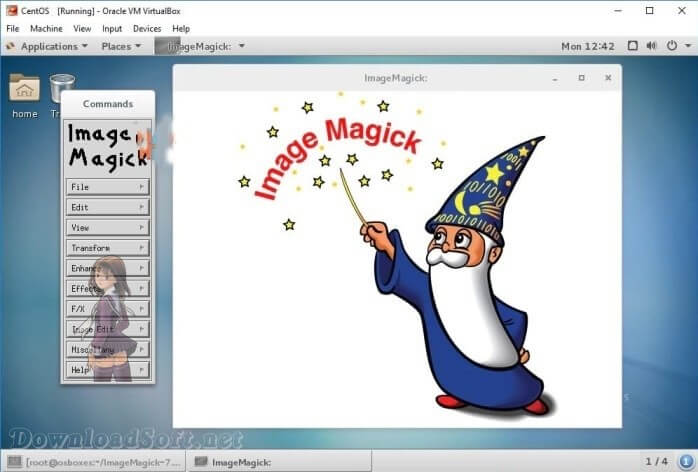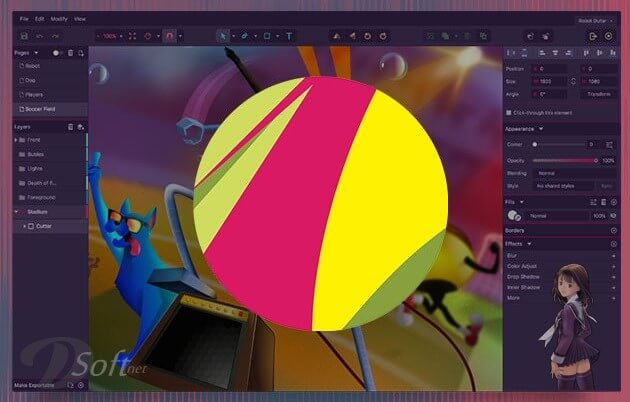ImageMagick Free Download 2024 More Rich for Windows and Mac
ImageMagick Free Download 2024 More Rich for Windows and Mac
ImageMagick is an easy-to-use program for editing, converting, creating, and configuring bitmap files. It is easy to use, but you should focus during the setup process because there are additional options that you can select.
For example, you can set your application’s directory path, perform legacy tool installations, associate file extensions supported by the program, and install libraries such as C++ and C.
A Comprehensive Guide to Image Processing and Manipulation
ImageMagick is a powerful, open-source image processing and manipulation software suite that allows users to perform a wide range of operations on images, including format conversion, resizing, cropping, rotating, and adjusting color levels.
With support for over 200 image formats, including popular formats such as JPEG, PNG, TIFF, and BMP, ImageMagick is a versatile tool that can be used for a variety of applications, from web design to scientific research.
In this article, we will explore the features and capabilities, as well as provide a guide on how to install and use the software.
ImageMagick Review
When you launch the program, you will see a well-organized classical-style interface. Unfortunately, you have to use the command line console to access most of the functionality available for the program.
If you don’t have technical skills, you may not find this very attractive. Bitmaps can be previewed on the user interface. A small amount of editing can be done as well.

Getting Started
ImageMagick can be downloaded for free from the official website and is available for Windows, macOS, and Linux operating systems. Once downloaded, installation is straightforward and can be completed in just a few minutes.
After installation, it can be accessed through the command line interface (CLI) or a graphical user interface (GUI) such as the one provided by the program ImageMagick Studio. The CLI is the more powerful option and provides access to the full range of features, while the GUI is more user-friendly and suitable for simpler tasks.
Basic Image Processing Operations
One of the main advantages is its ability to perform a wide range of basic image processing operations quickly and efficiently. Here are some examples of common tasks that can be accomplished using ImageMagick:
Converting Image Formats: Supports over 200 image formats, making it easy to convert between different file types. For example, to convert a JPEG image to a PNG image, you can use the following command in the CLI:
convert input.jpg output.png
Resizing Images: This can be used to resize images to specific dimensions or to scale them proportionally. For example, to resize an image to a width of 500 pixels, you can use the following command:
convert input.jpg -resize 500 output.jpg
Cropping Images: Crop images to a specific size or a specific aspect ratio. For example, to crop an image to a square shape, you can use the following command:
convert input.jpg -crop 1:1 output.jpg
Rotating Images: It can rotate images to a specific angle or a specific orientation (e.g., horizontal or vertical). For example, to rotate an image 90 degrees clockwise, you can use the following command:
convert input.jpg -rotate 90 output.jpg
Adjusting Color Levels: Adjust the brightness, contrast, saturation, and other color levels of images. For example, to increase the brightness of an image by 50%, you can use the following command:
convert input.jpg -brightness-contrast 50x0 output.jpgAdvanced Image Processing Operations
In addition to basic image processing operations, it also provides a range of advanced features for more complex tasks. Here are some examples of advanced image processing operations that can be accomplished using ImageMagick:
Image Filtering: A range of image filtering and enhancement options, including blurring, sharpening, and edge detection. For example, to apply a Gaussian blur to an image, you can use the following command:
magick input.jpg -blur 0x8 output.jpg
This command applies a Gaussian blur to the input image “input.jpg” with a standard deviation of 8 pixels in both the x and y directions, and saves the result as “output.jpg”. You can adjust the standard deviation and the kernel size to achieve different levels of blurring.
Morphological Operations: Morphological operations are used for image segmentation, noise reduction, and feature extraction. It provides a range of morphological operations, such as dilation, erosion, opening, and closing. For example, to perform a morphological opening operation on an image, you can use the following command:
magick input.jpg -morphology open Disk:3 output.jpg
This command applies a morphological opening operation to the input image “input.jpg” using a disk-shaped structuring element with a radius of 3 pixels, and saves the result as “output.jpg”. You can adjust the structuring element and the operation type to achieve different effects.
Color Manipulation: Manipulate the colors in an image in various ways, such as changing the brightness, contrast, saturation, or hue. For example, to increase the brightness of an image by 50%, you can use the following command:
magick input.jpg -modulate 150 output.jpg
This command applies a modulating operation to the input image “input.jpg”, which increases the brightness by 50%, and saves the result as “output.jpg”. You can adjust the values of the modulate option to achieve different levels of brightness, contrast, and saturation.
Image Segmentation: Provides tools for segmenting an image into multiple regions or objects based on their color, texture, or shape. For example, to segment an image into connected components using a threshold, you can use the following command:
magick input.jpg -threshold 50% -connected-components 8 -auto-level output.jpgThis command applies a threshold operation to the input image “input.jpg”, which converts all pixels above 50% brightness to white and all pixels below to black. Then it finds the connected components of the resulting binary image using 8-connectivity and applies an auto-level operation to adjust the contrast of the output image. You can adjust the threshold value and the connectivity to achieve different segmentation results.
These are just a few examples of the advanced image processing operations that can be accomplished. With its wide range of features and options, it is a powerful tool for manipulating and enhancing digital images.
Available Tools for Photos
Bitmap images can be converted to other file formats, such as BMP, JPEG, JPG, or PNG using the program. In addition, it allows you to rotate, resize, flip, skew, add shapes, trim, add borders, add blur, add a tint, or sharpen.
Other things that the program allows you to do include creating animations, inserting text, inserting montages, labeling components, extracting features, accessing external image pixels, overlapping images, and more. If you usually edit bitmaps and want a tool that is easy to use and has straightforward features, then you should consider getting ImageMagick.
Features
- Transparency: Makes parts of the image invisible.
- Special Effects: Blur, sharpen, select, or colorize the image.
- Animation: Create a GIF animation sequence from a set of images.
- Image definition: Describe the format and properties of an image.
- Montage: Place thumbnails side by side on a picture canvas.
- Image Calculator: Use an image or image channel to apply a mathematical equation.
- Large image support: read, process, or write mega and gigapixel image sizes.
- Text and Comments: Enter descriptive or artistic text in an image.
- Format conversion: Convert an image from one format to another (eg PNG to JPEG).
- Transform: Resize, rotate, crop, flip, or crop the image.
- Drawing: Add shapes or text to an image.
- Decorate: Add a border or frame to the photo.
- Composite: Overlaps one image on top of another.
- Motion picture support: Read and write common image formats used to make digital movies.
- HDR images: Accurately represent the wide range of intensity levels found in real scenes, ranging from the brightest direct sunlight to the deepest dark shadows.
- Threaded Execution Support: ImageMagick Free is thread-safe, and many internal algorithms are already interconnected to take advantage of the accelerations offered by dual and quad-core processor technologies.
✅ ALSO AVAILABLE: Download for Mac & Linux.

Technical Details
Software name: ImageMagick
- Category: Photos Editing Software
- License: Open Source
- File size: 43.49 MB
- Operating systems: Windows XP / Vista + SP1 / 7 / 8 / 10 / 11 / Mac / Linux and others
- Core 32/64-bit
- Languages: Supports many languages
- Developer: ImageMagick Studio LLC
- Official website: imagemagick.org
Minimum System Requirements
Check for the following system resources while running the program
- Operating system: Windows 11/10/8.1/8/7/Vista/XP/Mac or Linux system
- Memory (RAM): 2 GB or higher
- Hard Disk: 20 MB of free hard disk space
- Processor: Intel Pentium IV or higher
Download ImageMagick Free 2024





